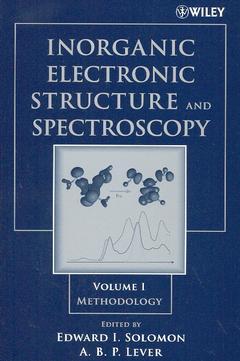Inorganic Electronic Structure and Spectroscopy, Volume I Methodology Inorganic Electronic Structure and Spectroscopy Series
Coordonnateurs : Solomon Edward I., Lever A. B. P.

This newly available paperbound edition of Inorganic Electronic Structure and Spectroscopy includes all the material from the original clothbound edition published in 1999. Consisting of articles contributed by outstanding scientists from around the world, Volume I, Methodology presents the state of the art in this field, written in a style accessible to the well-read senior undergraduate, and yet still of superior value to the senior researcher.
The first of a two-volume set, Volume I provides a thorough review of methodologies in transition metal spectroscopy and theoretical modeling, including:
* Electron Paramagnetic Resonance Spectroscopy
* IR, Raman, and Resonance Raman Spectroscopy
* Newer techniques used in inorganic chemistry, such as polarized absorption spectroscopy
* Luminescence spectroscopy
* Laser spectroscopy, X-ray and absorption spectroscopy, and EXAFS
* Three important chapters on traditional ligand field theory
This work assumes a basic understanding of quantum chemistry and group theory and reflects the current state of development for many of the techniques used by practicing inorganic chemists. Although written by multiple contributors, the editors' holistic approach to the manuscript has ensured a uniform presentation.
Contributors, Volume I.
Contents, Volume II.
Contributors, Volume II.
1. Ligand Field Theory and the Properties of Transition Metal Complexes (A. Lever & E. Solomon).
2. Electron Paramagnetic Resonance Spectroscopy (A. Bencini & D. Gatteschi).
3. Mössbauer Spectroscopy (P. Gütlich & J. Ensling).
4. Polarized Absorption Spectroscopy (M. Hitchman & M. Riley).
5. Luminescence Spectroscopy (T. Brunold & H. Güdel).
6. Laser Spectroscopy (E. Krausz & H. Riesen).
7. IR, Raman, and Resonance Raman Spectroscopy (R. Czernuszewicz & T. Spiro).
8. Photoelectron Spectra of Inorganic and Organometallic Molecules in the Gas Phase using Synchrotron Radiation (G. Bancroft & Y. Hu).
9. X-Ray Absorption Spectroscopy and EXAFS Analysis: The Multiple-Scattering Method and Applications in Inorganic and Bioinorganic Chemistry (H. Zhang, et al.).
10. Electronic Structure Calculations on Transition Metal Complexes: Ab-Initio and Approximate Models (C. Martin & M. Zerner).
11. Electronic Structure Calculations: Density Functional Methods with Applications to Transition Metal Complexes (J. Noodleman & D. Case).
Index.
Alfred Barry P. Lever is a Distinguished Research Professor (Emeritus) in the Department of Chemistry at York University in Toronto. He received his Ph.D. in 1960, from the Imperial College of Science and Technology in London. He is the Founding Editor of the journal Coordination Chemistry Reviews. This journal offers rapid publication of review articles on topics of current interest and importance in coordination chemistry, which includes aspects of organometallic, theoretical and bioinorganic chemistry. Professor Lever was, amongst other things, a Killam Research Fellow from 2000 through 2002, and was the 2002 recipient of the prestigious Linstead Award for Career Achievements in Phthalocyanine Chemistry.
Date de parution : 02-2006
Ouvrage de 752 p.
16x23.7 cm
Thème d’Inorganic Electronic Structure and Spectroscopy :
Mots-clés :
paperbound; inorganic; edition; material; electronic; available; spectroscopy; chemical education; contributed; outstanding scientists; around; world; articles; methodology; state; field; art; style; undergraduate; senior; accessible; wellread


